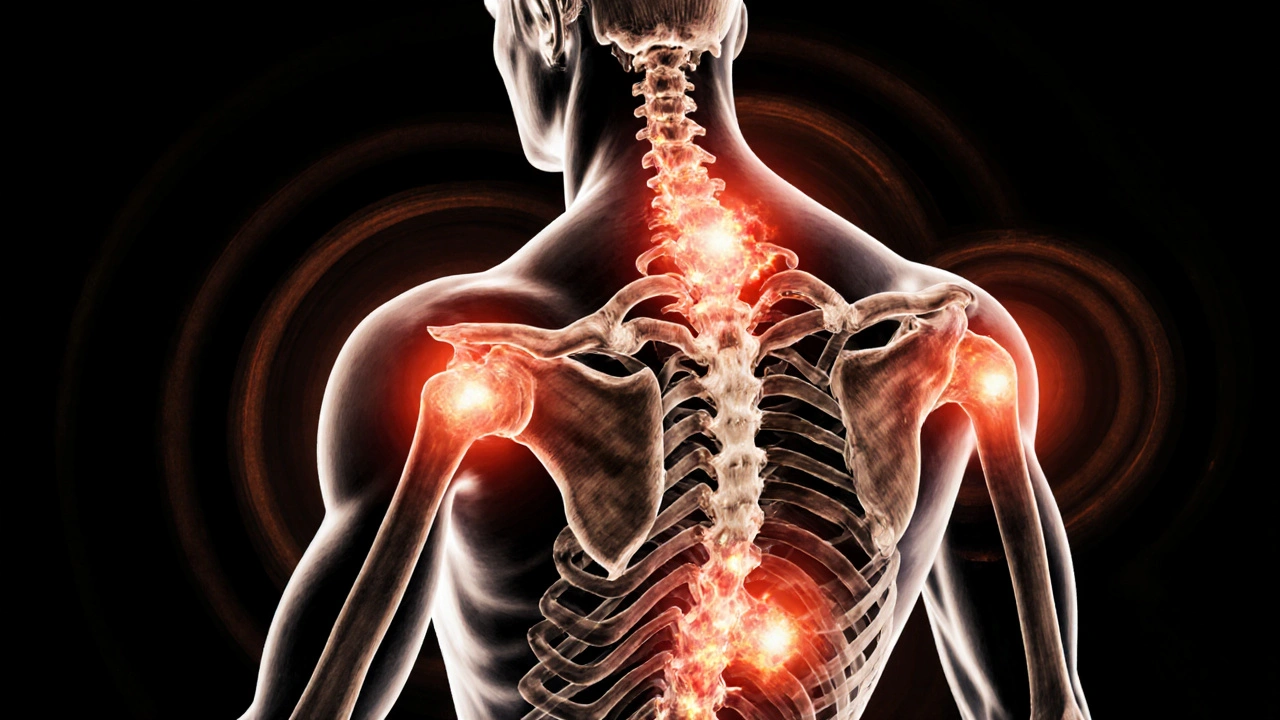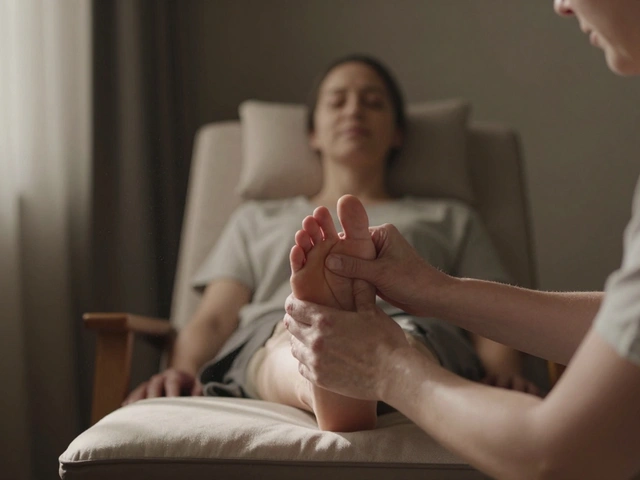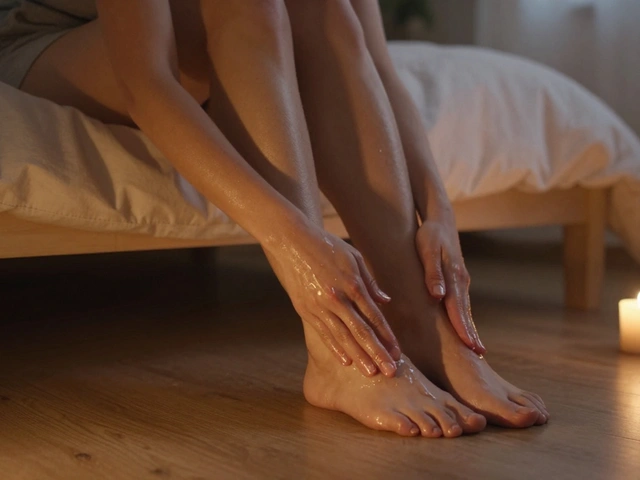Trigger Point Pain Finder
Find Your Pain Source
Select where you feel pain to identify potential trigger points and how to release them.
Ever feel like your shoulder or lower back is locked up-even after a good stretch or a long bath? You’re not just tense. You’ve got trigger points. These are tight, painful spots in your muscles that feel like little knots under your skin. They don’t go away with rest. They don’t vanish with a quick foam roller pass. But they can be released-with the right kind of pressure, at the right spot, for the right amount of time.
What Exactly Is a Trigger Point?
A trigger point is a hyperirritable spot in a muscle that’s stuck in constant contraction. Think of it like a tiny cramp buried deep inside your muscle fiber. When you press on it, it doesn’t just hurt where you touch-it sends pain elsewhere. That’s why your headache might be coming from a tight muscle in your neck, or why your knee pain could be linked to a knot in your hip.
These spots form from overuse, poor posture, stress, or injury. If you sit at a desk all day, you’re likely building trigger points in your upper traps, pecs, and hip flexors. If you run or cycle regularly, your quads, calves, and IT bands are prime targets. And if you’ve ever had a bad night’s sleep or gone weeks without moving well, those knots just get worse.
Unlike general muscle soreness, trigger point pain is sharp, localized, and often feels like a deep ache that won’t fade. It doesn’t respond to heat alone. It needs direct, sustained pressure.
How Trigger Point Massage Works
Trigger point massage isn’t about rubbing or kneading. It’s about holding. You find the knot, apply steady pressure-enough to feel a strong but tolerable ache-and hold it for 30 to 90 seconds. As you hold, the muscle fiber slowly relaxes. Blood flows back in. The chemical buildup that’s causing pain starts to flush out.
This technique is called ischemic compression. It cuts off blood flow briefly, then releases it, triggering a natural healing response. Studies from the Journal of Orthopaedic & Sports Physical Therapy show that consistent trigger point therapy reduces pain intensity by up to 70% in people with chronic neck and back pain within four weeks.
It’s not magic. It’s biology. Your body knows how to heal. You just need to give it the right signal.
Where to Find Common Trigger Points
You don’t need a map to find your trigger points-you need your fingers and a little curiosity. Here are the most common spots:
- Upper trapezius: Between your neck and shoulder. Often the source of tension headaches.
- Levator scapulae: Along the side of your neck, below the ear. Feels like a deep sting when you turn your head.
- Pectoralis minor: Under your collarbone. Tight here causes rounded shoulders and even tingling in your arms.
- Iliotibial band (IT band): Along the outside of your thigh. Causes knee pain that feels like it’s coming from the joint, but it’s really the muscle pulling on the tendon.
- Gastrocnemius and soleus: Your calves. Tight here leads to foot pain, plantar fasciitis, and stiff ankles.
Try this: Stand with your back against a wall. Roll a tennis ball between your shoulder blade and the wall. When you hit a spot that makes you wince? That’s your trigger point. Don’t move. Just breathe into it. After 45 seconds, the pain should soften. That’s the knot releasing.

Tools That Actually Work
You don’t need expensive gear. But you do need the right tool for the job.
A lacrosse ball is better than a foam roller for pinpoint pressure. A massage gun can help warm up the area, but it won’t hold long enough to release the knot. For deep glutes or hip flexors, a hard rubber ball (like a therapy ball from a physio clinic) works best.
For your back, try a spiky massage ball or even a frozen water bottle wrapped in a towel. The cold reduces inflammation while the spikes target multiple points at once. For your feet, roll a golf ball under your arch for two minutes each morning. It sounds simple-but it’s one of the most effective ways to stop morning heel pain.
And yes, your fingers work too. Use your thumb or knuckle. Don’t be afraid to press hard. The pain should be intense but not unbearable. If you’re gasping, ease off. You’re not trying to break bone-you’re trying to reset muscle.
How to Do It Yourself (Step-by-Step)
Here’s how to start your own trigger point routine:
- Find the spot. Use your fingers or a tool to roll slowly over the muscle. Stop when you hit a tender, deep knot.
- Apply steady pressure. Hold for 30 seconds. Breathe. Don’t hold your breath.
- If the pain lessens after 30 seconds, hold another 30. If it stays sharp, move slightly to the side and try again.
- Repeat 2-3 times per knot, once a day.
- After releasing, gently stretch the muscle. For example, after working your pecs, do a doorway chest stretch.
Do this for five minutes a day. That’s it. No fancy equipment. No appointments. Just you, your body, and a few minutes of focused attention.
When to Skip It (and When to See a Pro)
Trigger point massage is safe for most people. But skip it if:
- You have open wounds, bruises, or recent surgery in the area.
- You have numbness, tingling, or radiating pain down your arm or leg-that could be nerve-related, not muscle.
- You have osteoporosis, blood clots, or are on blood thinners.
If you’ve been massaging for two weeks and see no change, or if the pain spreads, it’s time to see a physiotherapist or licensed massage therapist who specializes in myofascial release. They can use techniques like dry needling or manual therapy that go deeper than you can do alone.
And if you’re dealing with chronic pain that keeps coming back? Trigger points are often just one piece. Poor sleep, stress, dehydration, or even breathing patterns can keep them alive. Fix the trigger point, but also fix the habits that made it.

Why This Works Better Than Stretching Alone
Stretching a muscle with a trigger point is like trying to stretch a rubber band that’s tied in a knot. You’ll feel tension, but the knot stays. You might even make it worse.
Trigger point massage unties the knot first. Then stretching works. That’s why people who stretch daily but still feel tight never get relief. They’re missing the first step.
Think of it like cleaning a clogged drain. You don’t just turn on the water-you use a plunger first. Trigger point work is the plunger. Stretching is the water flow.
Real Results, Real Time
One woman in Perth, 52, had shoulder pain for three years. She’d tried acupuncture, chiropractic care, and physical therapy. Nothing stuck. She started doing 10 minutes of trigger point work on her upper traps and pecs every morning with a lacrosse ball. After three weeks, she could sleep on her side again. After six weeks, she stopped taking painkillers. She didn’t change her job. She didn’t start yoga. She just released the knots.
Another guy, 38, had constant lower back pain after long drives. He thought it was his spine. Turns out, it was his hip flexors. He started rolling a tennis ball under his front hip every night before bed. In two weeks, his pain dropped from a 7/10 to a 2/10. He didn’t know trigger points existed before that.
These aren’t outliers. They’re people who learned how to listen to their bodies.
Make It a Habit
Trigger point massage isn’t a one-time fix. It’s maintenance. Like brushing your teeth, it’s something you do every day because it keeps you from falling apart.
Set a reminder. Do it while watching TV. Do it after your shower. Do it before bed. Keep a lacrosse ball on your desk. Roll it under your foot while you’re on a call. Keep it in your car. Make it part of your routine-not a chore.
Your body doesn’t need more workouts. It needs more care. Trigger point massage is the simplest, most powerful way to give it that.
Can trigger point massage help with headaches?
Yes, especially tension headaches. Many headaches come from tight muscles in the neck and upper back, particularly the upper trapezius and levator scapulae. Applying pressure to these trigger points for 45-60 seconds can reduce headache frequency and intensity. Studies show that people who do this daily cut their headache days in half within four weeks.
How often should I do trigger point massage?
Once a day is ideal for active knots. If you’re just maintaining, 3-4 times a week is enough. Don’t overdo it-if your skin is sore or bruised, take a day off. Your muscles need time to recover, just like after a workout.
Is trigger point massage the same as foam rolling?
No. Foam rolling is good for warming up large muscle groups and improving circulation. But it doesn’t apply enough focused pressure to release a deep trigger point. A lacrosse ball or massage tool targets one spot at a time, which is what you need to unlock a knot. Use foam rolling before, and trigger point work after.
Why does pressing on a knot hurt so much?
Trigger points are packed with inflammatory chemicals and nerve endings. When you press on them, you’re stimulating those nerves directly. The pain is your body’s way of saying, “Something’s wrong here.” But the pain lessens as the muscle relaxes-because you’re fixing the problem, not making it worse.
Can trigger points cause numbness or tingling?
Yes. Tight muscles can compress nearby nerves. For example, a knot in your chest (pectoralis minor) can press on the brachial plexus, causing tingling in your fingers. Releasing the trigger point often fixes the numbness. If it doesn’t, see a professional-this could be a nerve issue needing more than massage.
Trigger point massage doesn’t promise miracles. But it does deliver real, measurable relief-if you’re willing to be consistent. It’s not glamorous. It’s not quick. But it’s one of the most effective things you can do for your body without spending a dollar or leaving your home.







